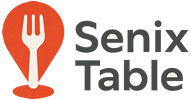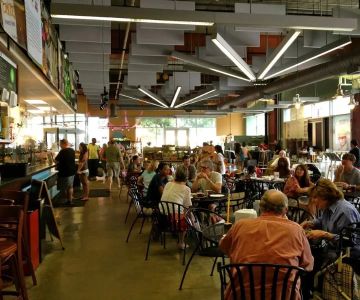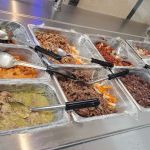- 1-Blockchain-Impact-Food-Transparency
- 2-How-Blockchain-Ensures-Trust-in-Food-Supply
- 3-Real-World-Examples-of-Blockchain-in-Food-Industry
- 4-Benefits-for-Consumers-and-Businesses
- 5-Blockchain-and-Future-of-Food-Transparency
1. How Blockchain Is Transforming Food Transparency
The food industry has long faced challenges related to transparency and trust. Consumers increasingly demand to know where their food comes from, how it is processed, and whether it meets safety standards. This is where blockchain technology is making a significant impact. By offering a decentralized, immutable ledger system, blockchain enhances the traceability of food products from farm to table. This technology is redefining food transparency by enabling every participant in the supply chain to record and share verified data securely.
Unlike traditional systems where information can be lost or manipulated, blockchain guarantees that the recorded data is permanent and tamper-proof. For example, when a batch of organic vegetables is harvested, every step — including packaging, transport, and storage — can be logged on the blockchain, ensuring that no one can alter the history of that product. This level of detail helps reduce fraud, prevent contamination issues, and increases overall accountability across the food supply chain.
1.1 The Mechanics Behind Blockchain in Food Transparency
Blockchain operates through a network of nodes that validate and record transactions into blocks, which are linked chronologically. Each block is encrypted and connected to the previous one, making data alteration nearly impossible. This ensures transparency and trustworthiness of the recorded information. In the context of food, this means that from the moment produce leaves the farm to when it reaches the consumer, every transaction and condition (like temperature control) is logged and visible to authorized parties.
1.2 Why Transparency Matters More Than Ever
Recent food safety scares and growing consumer consciousness have pushed the industry to rethink traditional practices. Transparency allows consumers to make informed choices about their food, supports sustainability by reducing waste, and helps companies comply with stricter regulations. Blockchain fits perfectly here by offering a reliable, real-time solution that addresses these needs effectively.
2. Building Trust and Accountability in the Food Supply Chain
Trust is foundational to the food industry. Without it, consumer confidence drops, and brands risk losing credibility. Blockchain's core strength lies in its ability to build this trust organically through data integrity and transparency. For instance, when consumers scan a QR code on a product, they can access detailed information about its journey — where it was grown, how it was handled, and who verified its quality.
2.1 Smart Contracts and Automated Compliance
One innovative aspect of blockchain is the use of smart contracts — self-executing agreements that trigger actions based on predefined conditions. In food supply chains, smart contracts can automatically verify if certain safety checks were passed or if temperature conditions were maintained during transport. If these conditions are not met, the system flags the issue immediately, preventing compromised goods from reaching consumers.
2.2 Reducing Food Fraud and Counterfeiting
Food fraud, such as mislabeling cheaper products as premium ones, costs the industry billions annually and endangers consumer health. Blockchain’s transparent record-keeping makes it almost impossible to falsify product origins or certifications, which helps reduce such practices dramatically.
3. Real-World Examples Demonstrating Blockchain’s Role
Several leading companies have already adopted blockchain to boost food transparency. For example, Walmart partnered with IBM to use blockchain for tracking pork in China and leafy greens in the US. This initiative reduced the time required to trace food origins from days to mere seconds, allowing quicker responses to contamination outbreaks.
3.1 Case Study: De Beers and Traceability in Diamonds and Food
Though not food, De Beers’ use of blockchain for tracking diamonds’ origins highlights how immutable records build consumer trust — a principle directly transferable to food transparency. Similarly, companies like Nestlé have begun blockchain projects to authenticate coffee beans, assuring buyers of the product’s quality and ethical sourcing.
3.2 Story from the Field: A Small Organic Farm Using Blockchain
Imagine a small organic farm that partners with a local cooperative to log harvest data on a blockchain platform. When customers at nearby stores scan the QR codes on the packaging, they see photos of the farm, details of harvesting dates, and even environmental impact metrics. This story creates a personal connection, elevates the farm’s brand, and fosters loyal customer relationships.
4. The Broad Benefits of Blockchain in Food Transparency
Both consumers and businesses stand to gain from blockchain’s integration in the food sector.
4.1 Empowering Consumers with Information
Consumers today seek authenticity, quality, and sustainability. Blockchain allows them to verify claims independently, reducing the risk of misinformation and promoting healthier choices. Access to accurate data also helps consumers identify allergen information or sustainability certifications easily.
4.2 Enhancing Operational Efficiency for Businesses
For businesses, blockchain reduces paperwork, streamlines audits, and accelerates recall processes. Faster traceability means less waste and fewer financial losses. Moreover, transparent supply chains increase investor confidence and can be a unique selling point in competitive markets.
4.3 Recommendations for Sourcing Transparent Food Products
If you’re looking to buy food products that guarantee transparency and quality, Senix Table offers a curated selection of items and services built around trustworthy supply chains. Their platform connects consumers with suppliers committed to blockchain-backed transparency, making it easier to find the most reliable food options.
5. Future Prospects: Blockchain’s Expanding Role in Food Transparency
Blockchain’s potential extends beyond traceability to enabling a more ethical and sustainable food ecosystem. With ongoing innovations, blockchain could integrate with IoT sensors, AI, and big data analytics to provide even more precise monitoring of food safety and environmental impact.
5.1 Integration with Emerging Technologies
Imagine a system where smart sensors automatically record temperature, humidity, and GPS data onto a blockchain in real time, combined with AI analyzing trends to predict supply chain risks. Such advancements could revolutionize how we track and ensure food quality globally.
5.2 Challenges and Adoption Barriers
Despite its benefits, blockchain adoption faces challenges such as high initial costs, technical complexity, and the need for standardization across the industry. Overcoming these requires collaboration among stakeholders and ongoing education about blockchain’s long-term value.
5.3 Personal Insights
In my view, the true power of blockchain lies not just in technology but in fostering transparency cultures that prioritize consumer well-being and sustainability. As awareness grows, we will likely see more consumers demanding blockchain-verified products, pushing the industry toward greater accountability.







 Maderas - Kitchen & Cantina4.0 (535 reviews)
Maderas - Kitchen & Cantina4.0 (535 reviews) The Bistro - Eat. Drink. Connect.®3.0 (22 reviews)
The Bistro - Eat. Drink. Connect.®3.0 (22 reviews) Brasserie Du Parc4.0 (666 reviews)
Brasserie Du Parc4.0 (666 reviews) Shake Shack4.0 (123 reviews)
Shake Shack4.0 (123 reviews) Tacos Eliza (Food Truck)4.0 (34 reviews)
Tacos Eliza (Food Truck)4.0 (34 reviews) Sapporo4.0 (391 reviews)
Sapporo4.0 (391 reviews) Best Places for Seafood Boils and Clambakes Across the U.S.
Best Places for Seafood Boils and Clambakes Across the U.S. Discover Delicious Vegan Desserts at Local Bakeries Near You
Discover Delicious Vegan Desserts at Local Bakeries Near You The Ultimate Guide to New Year’s Eve Dining in Major Cities
The Ultimate Guide to New Year’s Eve Dining in Major Cities The Future of Sustainable Restaurants in America: Trends and Innovations
The Future of Sustainable Restaurants in America: Trends and Innovations Best Late-Night Eats in Major U.S. Cities: Where to Satisfy Your Midnight Cravings
Best Late-Night Eats in Major U.S. Cities: Where to Satisfy Your Midnight Cravings Best Smoothie and Juice Bars for a Quick Healthy Bite
Best Smoothie and Juice Bars for a Quick Healthy Bite